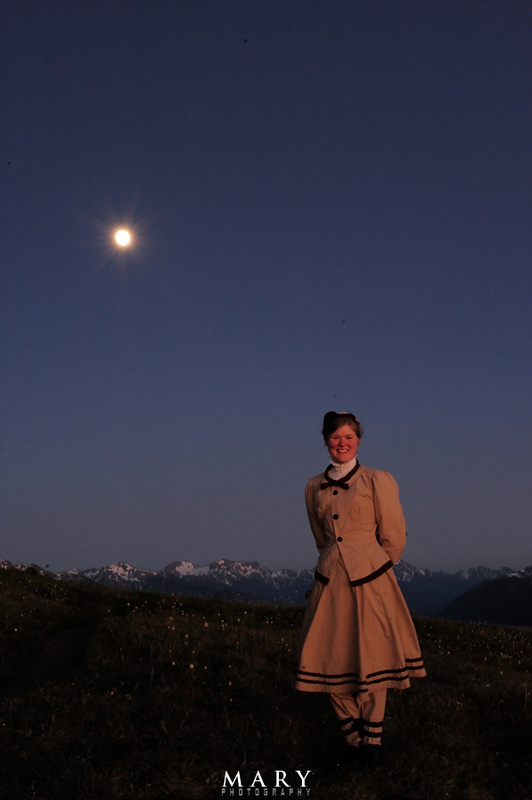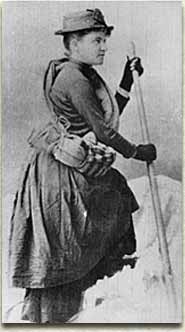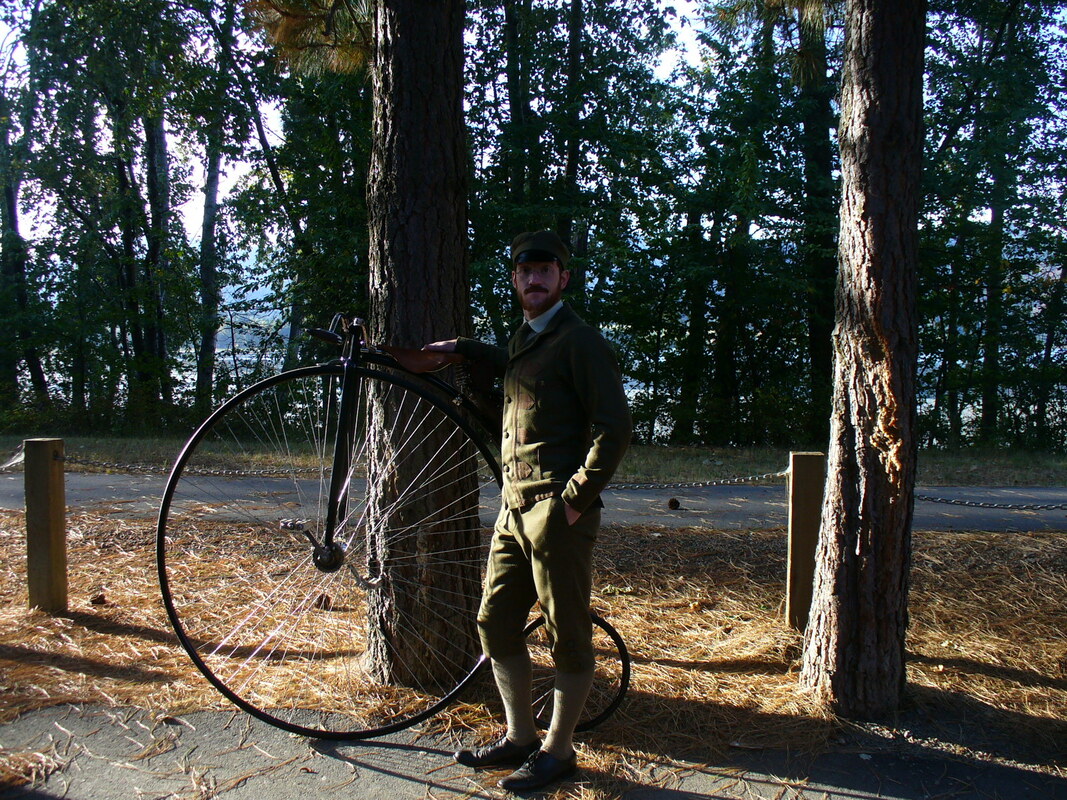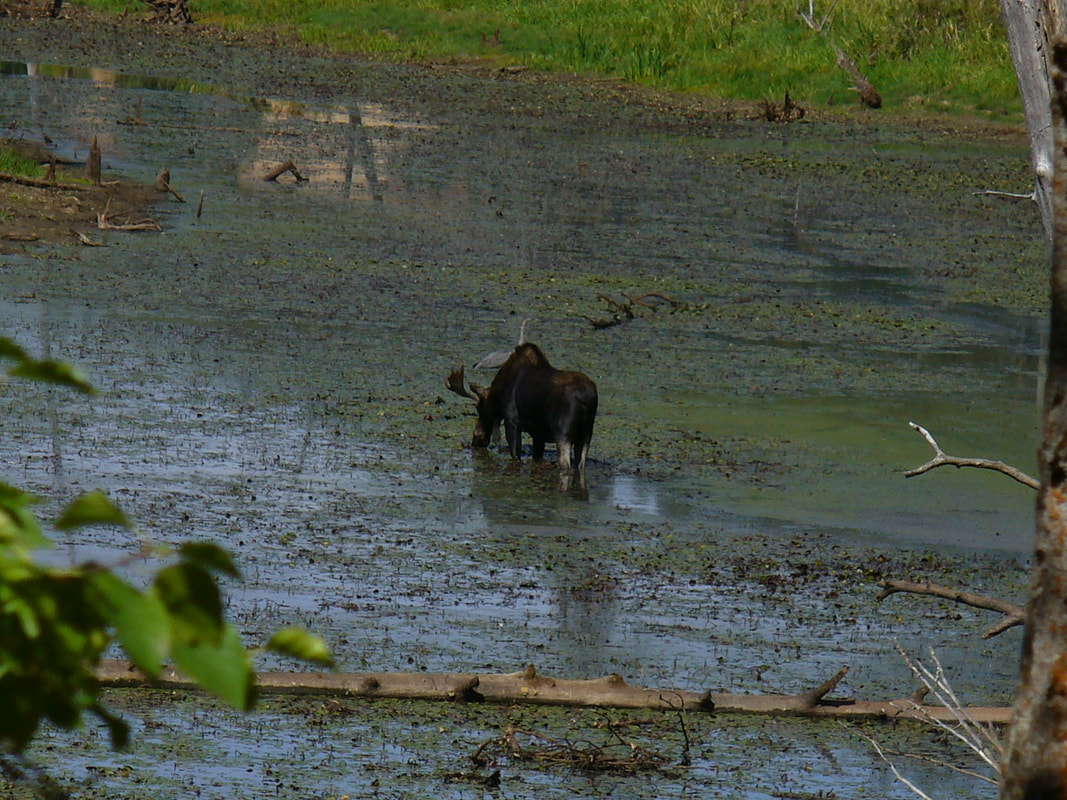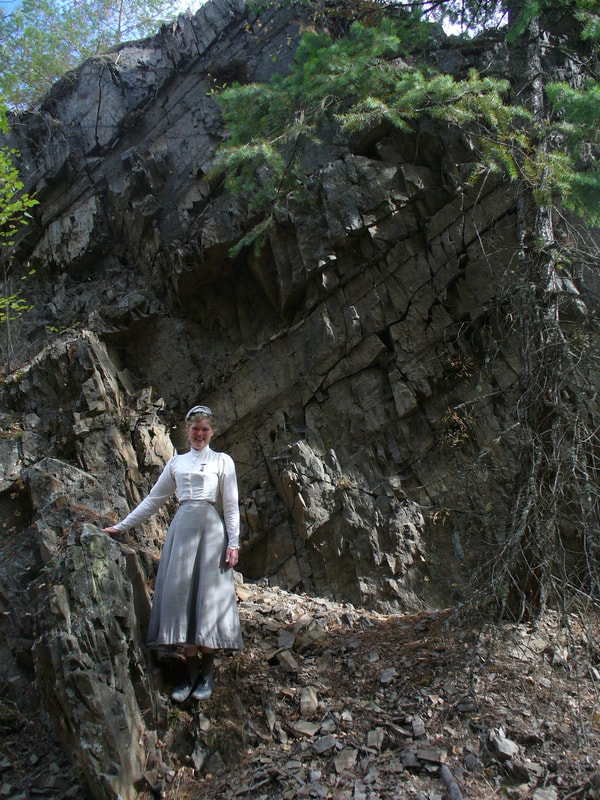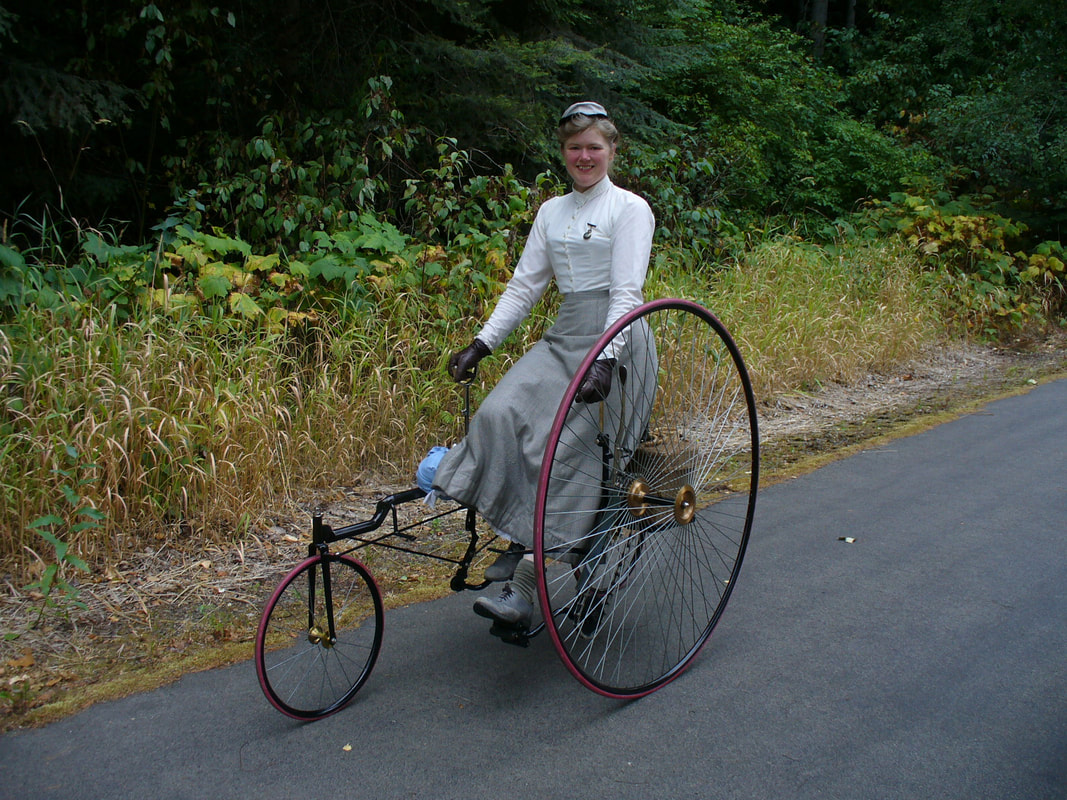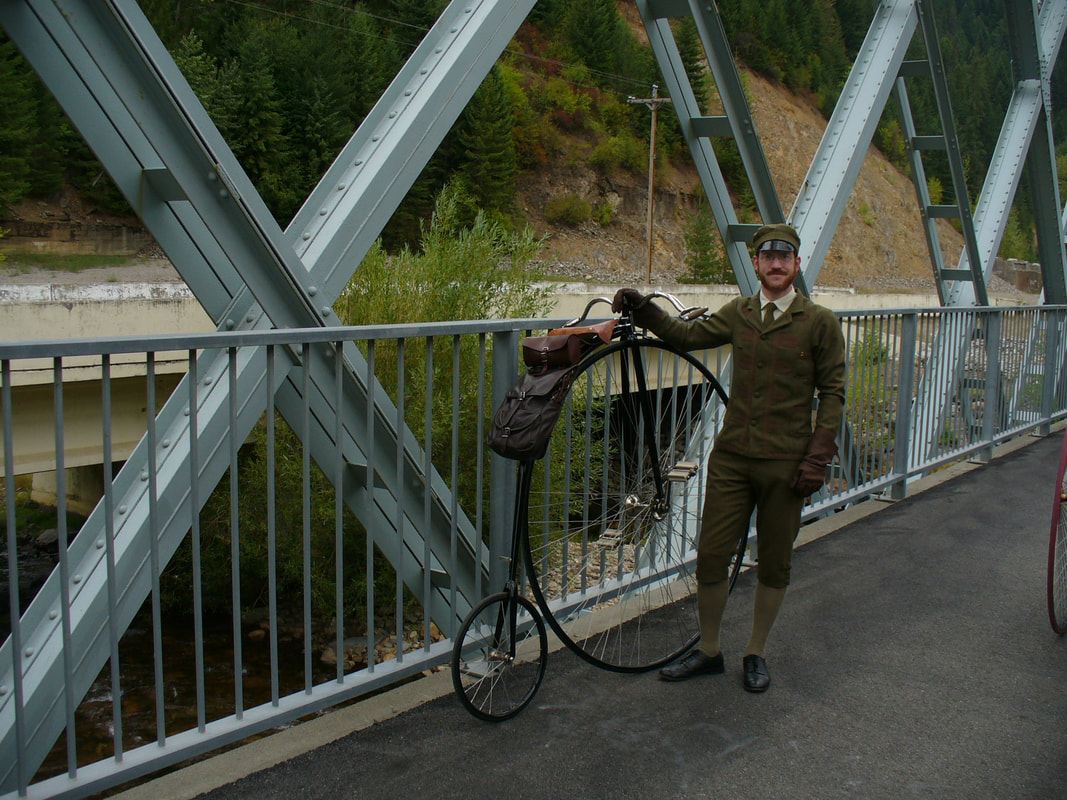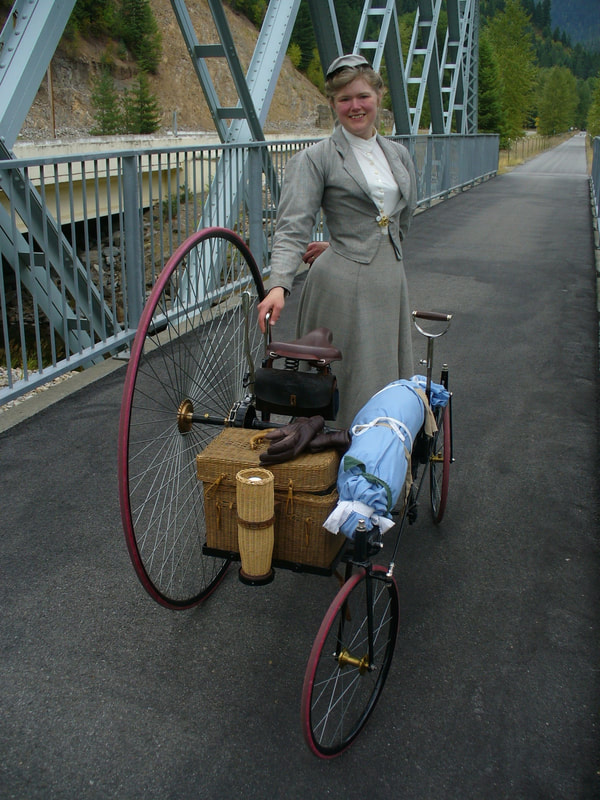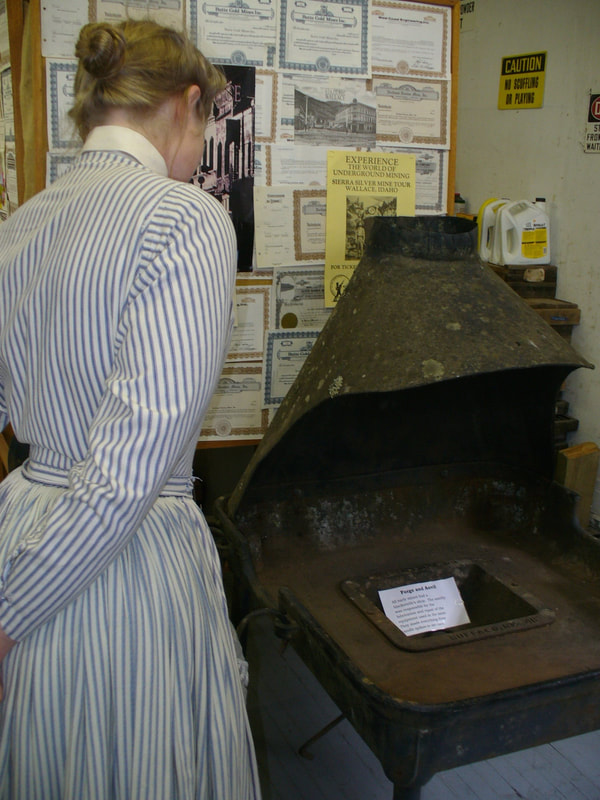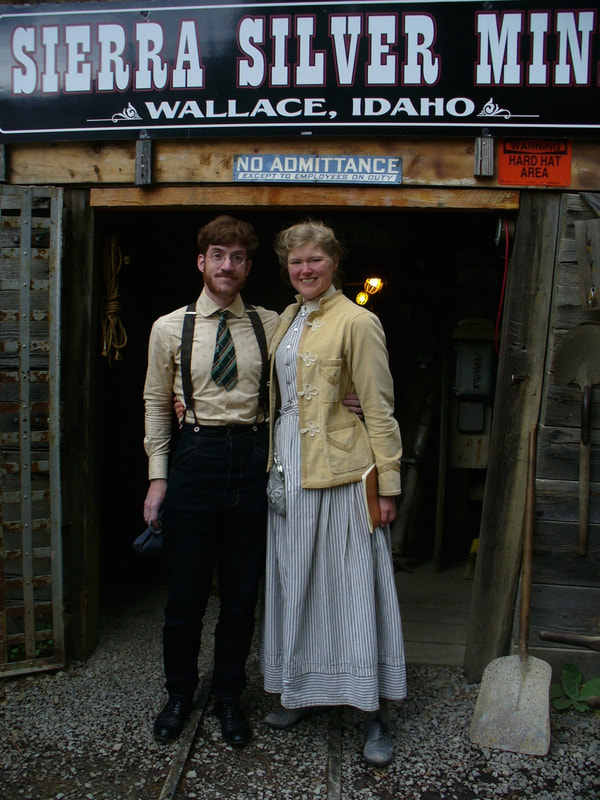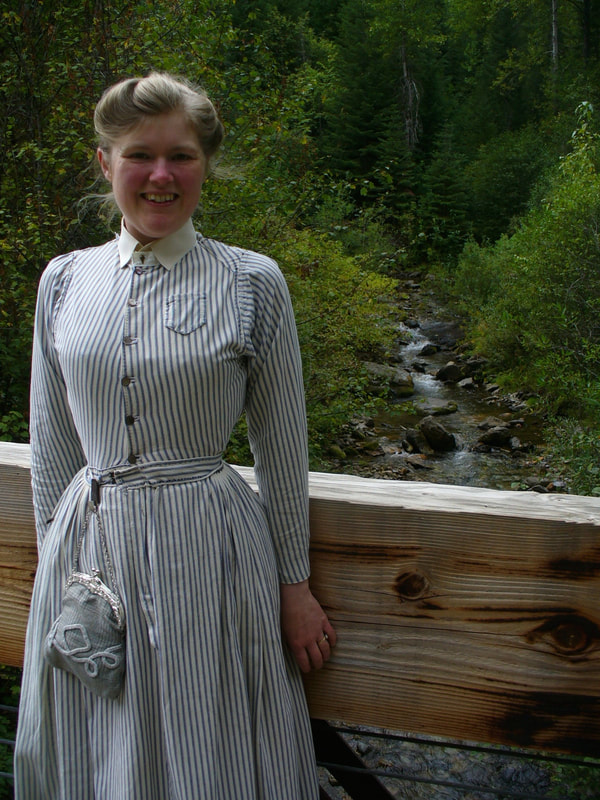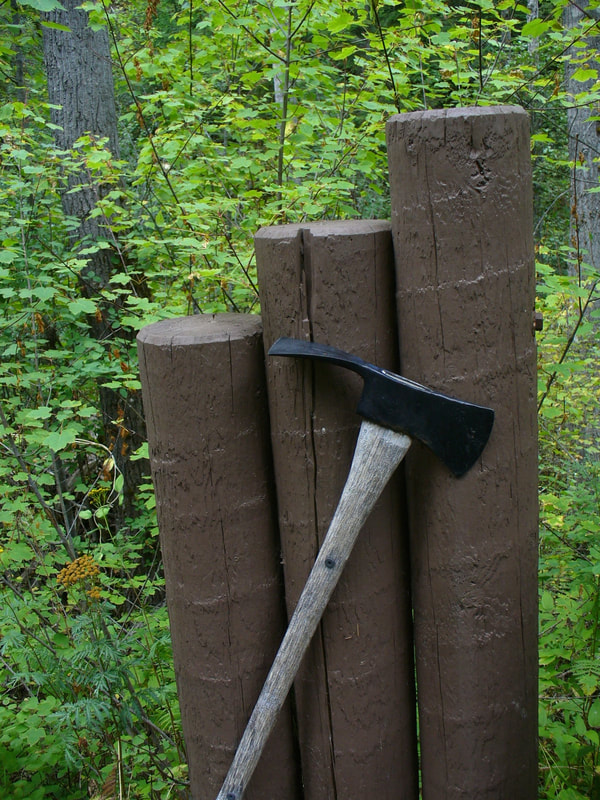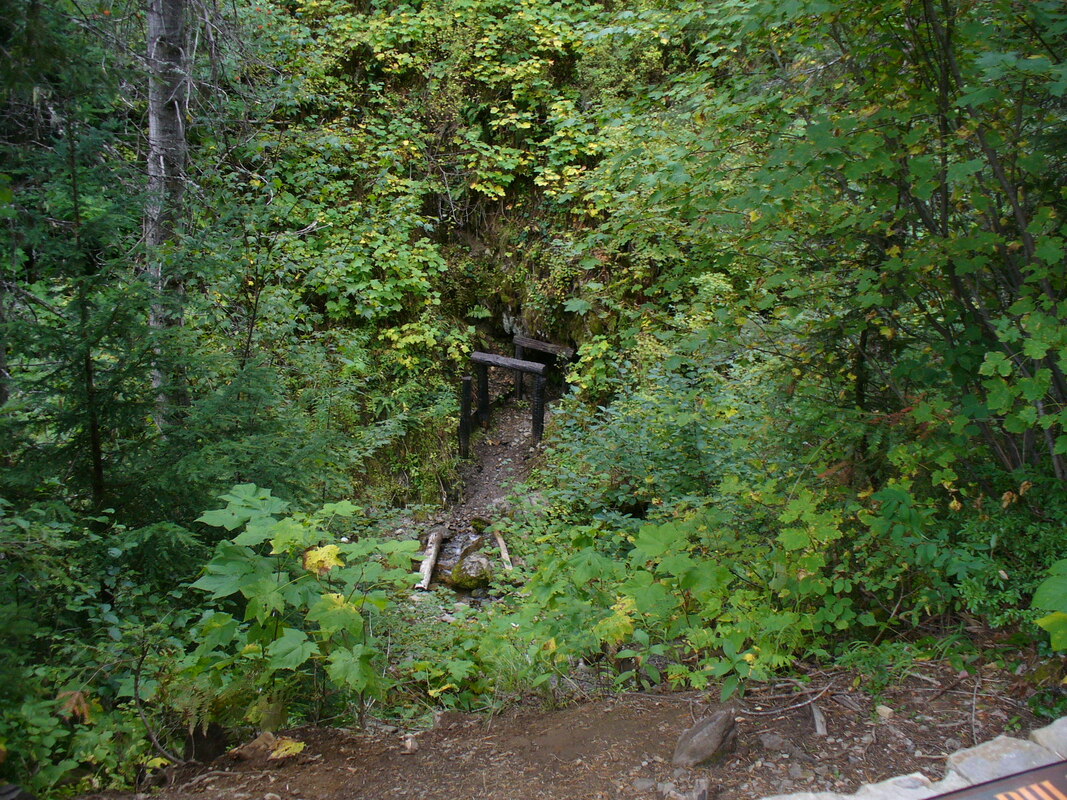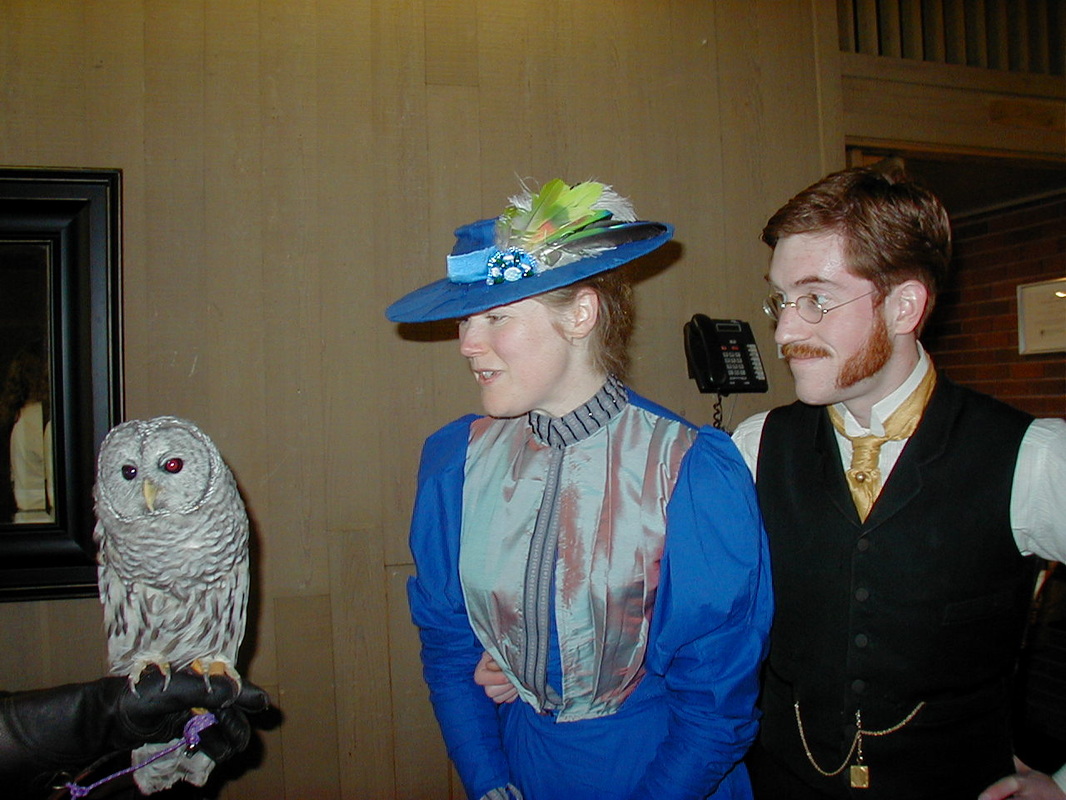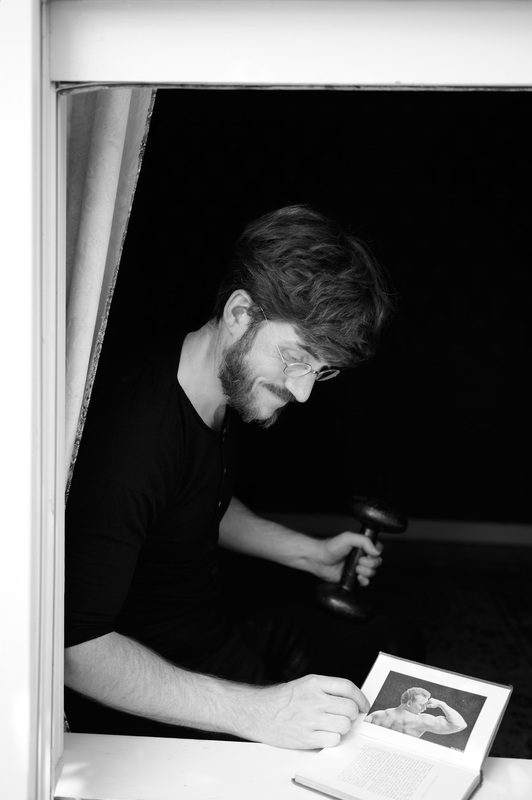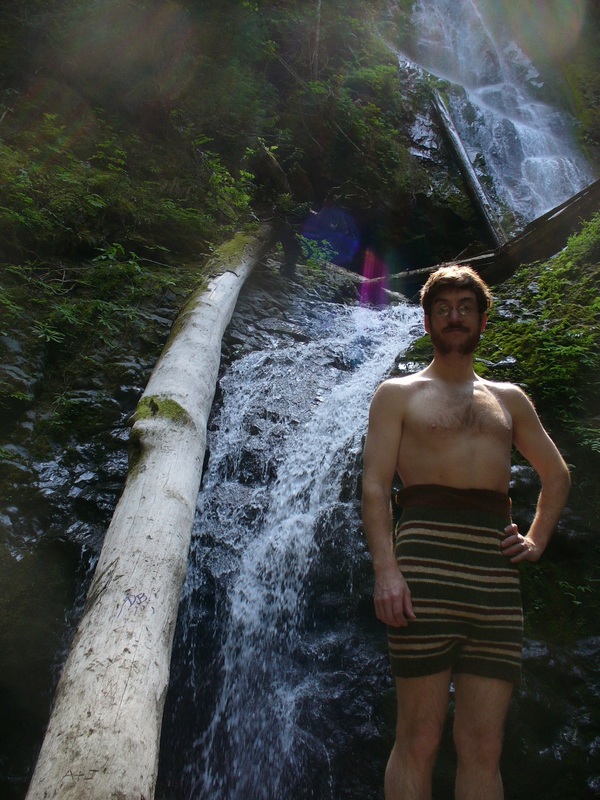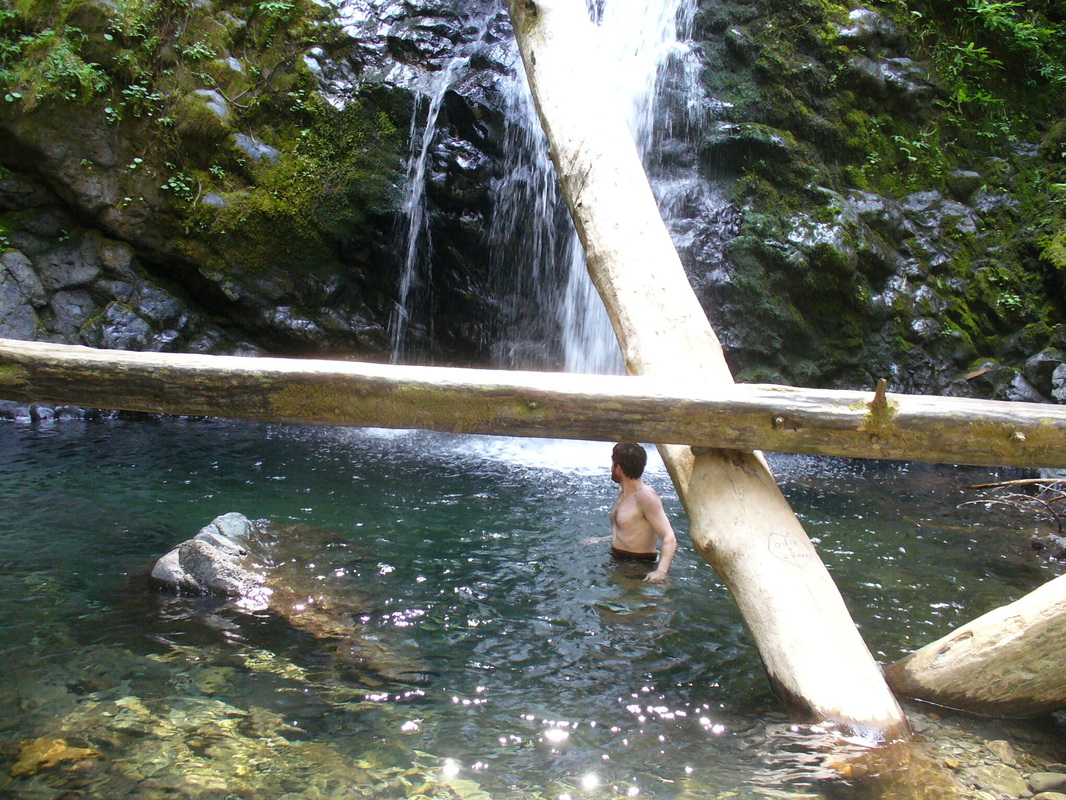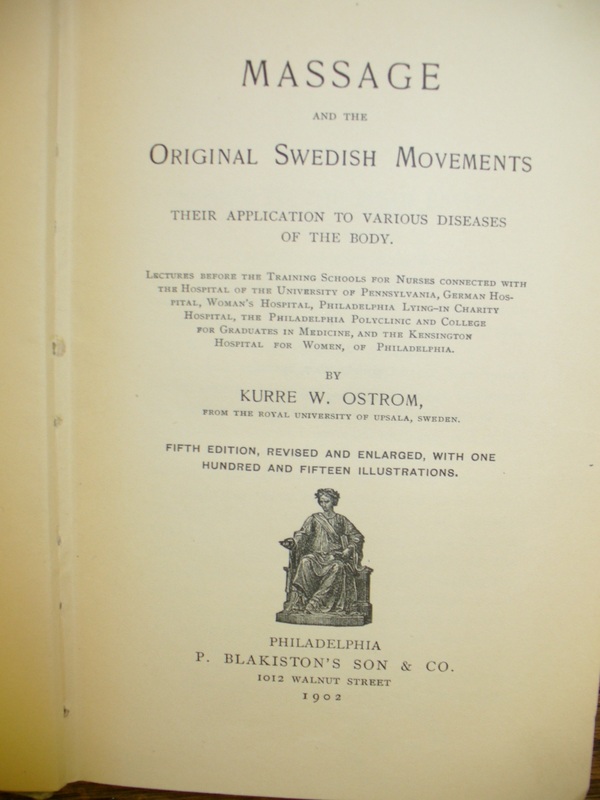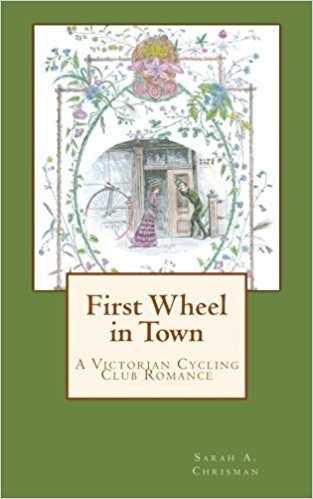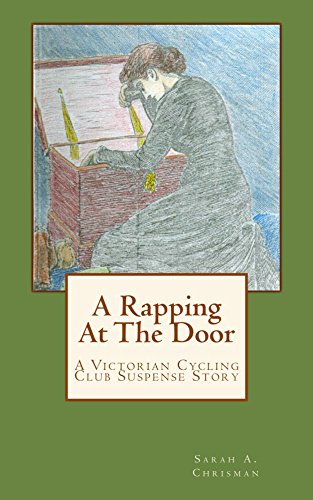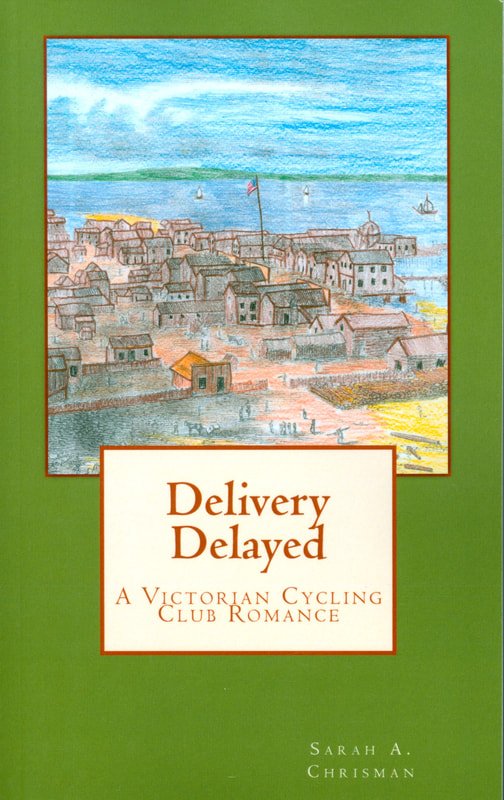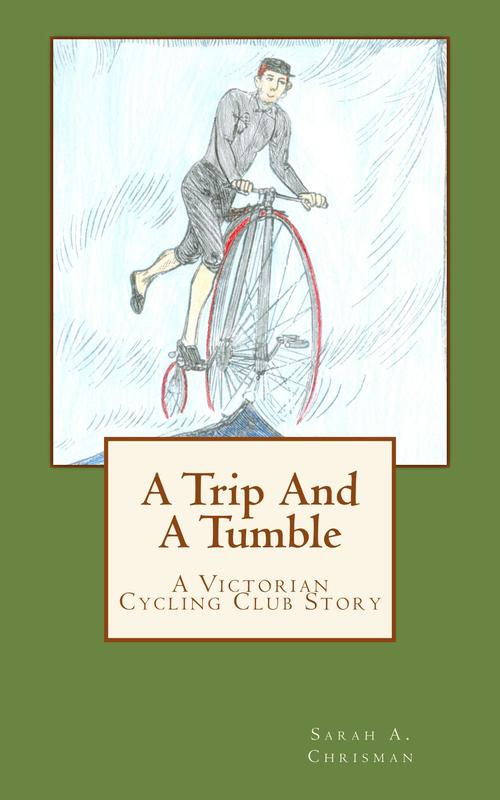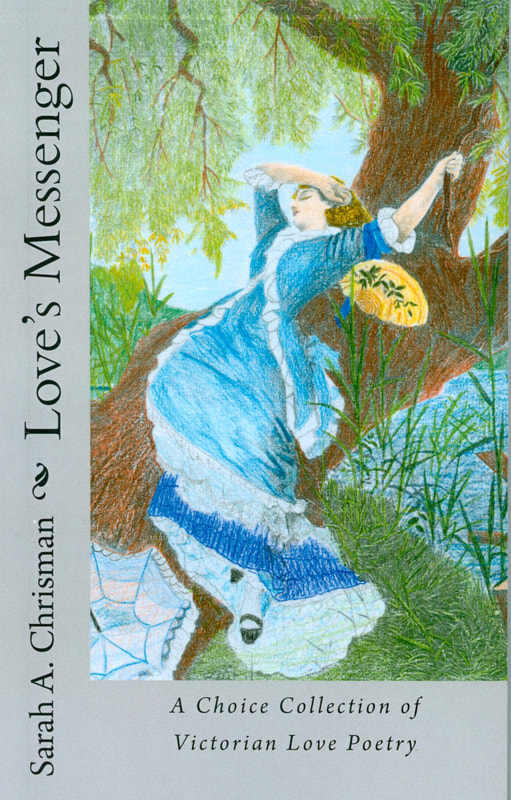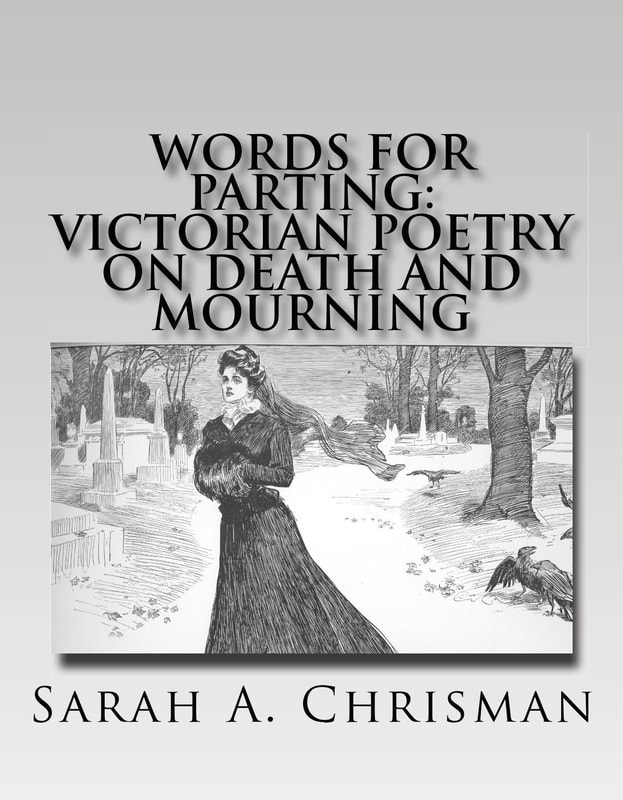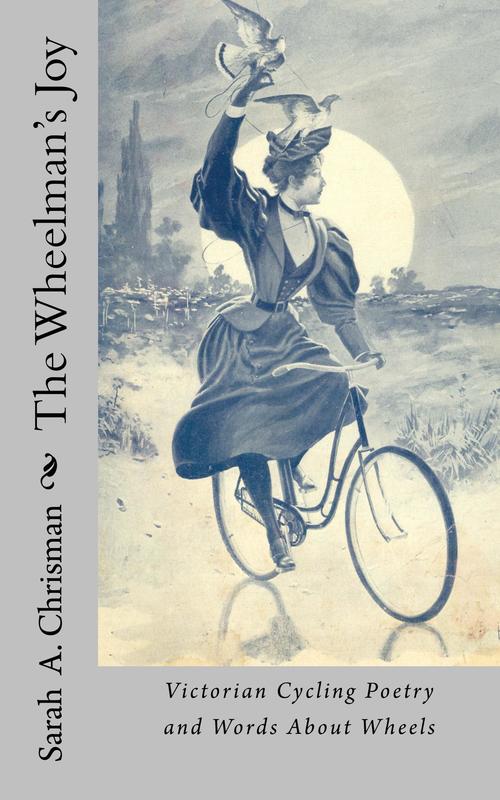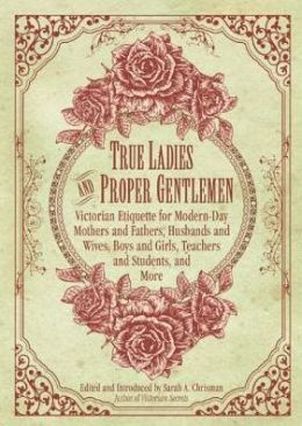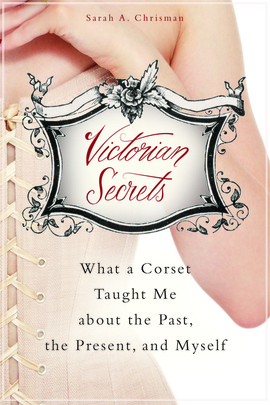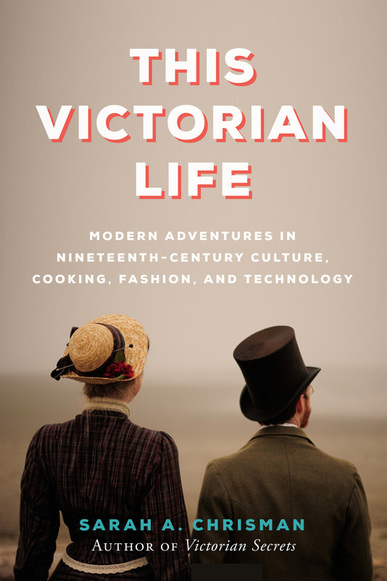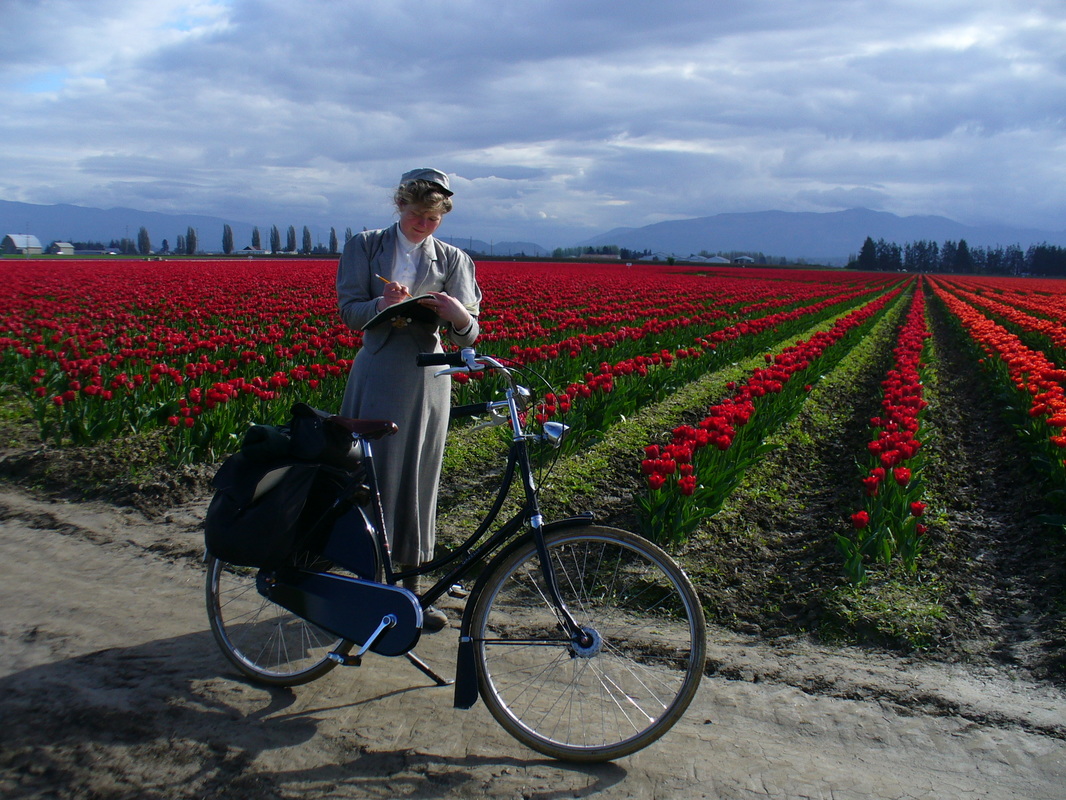Leisure Activities
(Be sure to check out our cycling page as well!)
Maintaining this website (which you are enjoying for free!) takes a lot of time and resources.
Please show your support for all our hard work by telling your friends about Sarah's books —and by buying them yourself, too, of course!
Hiking
Sarah's hiking outfit was inspired by the dress Fay Fuller wore in 1890 when she became the first woman to summit Mt. Rainier - the highest mountain in our state. To read more about Miss Fuller, visit: http://mtn.tpl.lib.wa.us/climbs/climbing/people/fuller.asp
Hiking slideshow:
Our Vacation on the Trail of the Coeur d'Alene's
September, 2015
For our vacation in 2015, Gabriel and I spent a week riding our high wheel cycles along the Trail of the Coeur d'Alene's in the Idaho panhandle. This marvelous path is part of the Rails to Trails program. Back in the late 19th-century, the route we were following was part of the Union Pacific Railroad line. Unfortunately, in the 20th-century when cars superseded passenger trains, the lines became defunct. Sections of the old railroads have recently been converted to paths for cyclists and pedestrians—for more on the Rails to Trails program, see http://www.railstotrails.org. The Trail of the Coeur d'Alene's, the route we were following, goes between tiny towns and abandoned silver mines in the Idaho panhandle. There are still plenty of functional mines in the region, and this area remains the silver capital of the world. For more on the Trail of the Coeur d'Alene's, see: https://friendsofcdatrails.org/trail-of-the-coeur-dalenes/
With my trike, on a bridge on the Trail of the Coeur d'Alene's. This photo shows how much more carrying capacity the Victorian tricycles had than their brother bicycles. The blue bundle strapped to the long rod between the little steering wheels is a canvas roll containing our spare clothes. In the 1880s, men usually chose Ordinary bicycles over tricycles because the bikes were lighter and simpler; male tricyclists were either geeks who preferred complicated technology, or men who wanted extra luggage space—hunters, photographers or artists. (A gun, tripod or easel could be strapped to the long rod of the trike just like I strapped our clothes there.)
For more information about Victorian high wheels in general —and ours in particular-- see our Cycling page.
Wallace, Idaho
After riding our high wheel cycles more than seventy-five miles along the Trail of the Coeur d'Alene's, we arrived in historic Wallace, Idaho. Wallace is a lovely little town; founded in 1884 it dates from right in our period. The whole town is on the National Register of Historic Places, and it boasts some wonderful Victorian architecture. The people were wonderfully welcoming and friendly, and we truly enjoyed our time there.
For more on Wallace, see http://wallace-id.com
Museums in Wallace:
Northern Pacific Depot Railroad Museum
NPDRM on Facebook
Wallace District Mining Museum
WDMM on Facebook
Sierra Silver Mine
SSM on Facebook
For more information about Victorian high wheels in general —and ours in particular-- see our Cycling page.
Wallace, Idaho
After riding our high wheel cycles more than seventy-five miles along the Trail of the Coeur d'Alene's, we arrived in historic Wallace, Idaho. Wallace is a lovely little town; founded in 1884 it dates from right in our period. The whole town is on the National Register of Historic Places, and it boasts some wonderful Victorian architecture. The people were wonderfully welcoming and friendly, and we truly enjoyed our time there.
For more on Wallace, see http://wallace-id.com
Museums in Wallace:
Northern Pacific Depot Railroad Museum
NPDRM on Facebook
Wallace District Mining Museum
WDMM on Facebook
Sierra Silver Mine
SSM on Facebook
At the office for the Sierra Silver Mine tour. A trolley took us from this building out to the mine itself.
The piece of equipment in the photo is an antique forge. The sign reads, "All early mines had a blacksmith's shop. The smith was responsible for the fabrication and repair of the equipment used in the mine. They made everything from candle spikes to ore cars."
The piece of equipment in the photo is an antique forge. The sign reads, "All early mines had a blacksmith's shop. The smith was responsible for the fabrication and repair of the equipment used in the mine. They made everything from candle spikes to ore cars."
There are still plenty of very profitable mines in the area, but this particular one no longer produces enough ore to be lucrative, so it has been opened up for tours. A retired miner showed us around and demonstrated their very impressive equipment.
It was cold that morning so I stole Gabriel's jacket. The jacket itself has a particularly interesting history related to mines. It was copied from an original antique. We bought the original from a man who explores abandoned mining camps (it didn't come from this particular mine, but it's still a fun connection). The seller had found this jacket when investigating a mine shaft that had caught on fire back in the late 19th-century. The jacket (along with whatever else was to hand at the time) had been shoved into the cracks around the door blocking the shaft in an attempt to smother the blaze. When the entrance to the mine later collapsed, the jacket was buried in an environment with virtually no oxygen - thus preserving it until it was found in the 21st century. Katherine Andrews studied the original, and made a copy of this unique garment for Gabriel to wear on a daily basis—except when I steal it! There are pictures of the original antique here: http://www.thisvictorianlife.com/everyday-clothes.html (The jacket pictures are about 2/3 of the way down the page, below the picture of Gabriel's swimming trunks and above the pictures of my hiking dress.)
It was cold that morning so I stole Gabriel's jacket. The jacket itself has a particularly interesting history related to mines. It was copied from an original antique. We bought the original from a man who explores abandoned mining camps (it didn't come from this particular mine, but it's still a fun connection). The seller had found this jacket when investigating a mine shaft that had caught on fire back in the late 19th-century. The jacket (along with whatever else was to hand at the time) had been shoved into the cracks around the door blocking the shaft in an attempt to smother the blaze. When the entrance to the mine later collapsed, the jacket was buried in an environment with virtually no oxygen - thus preserving it until it was found in the 21st century. Katherine Andrews studied the original, and made a copy of this unique garment for Gabriel to wear on a daily basis—except when I steal it! There are pictures of the original antique here: http://www.thisvictorianlife.com/everyday-clothes.html (The jacket pictures are about 2/3 of the way down the page, below the picture of Gabriel's swimming trunks and above the pictures of my hiking dress.)
The Pulaski Tunnel Trail
After safely stowing our cycles in Wallace, we went hiking along the Pulaski Tunnel Trail. This trail commemorates a 1910 event —a few years later than our usual focus, but extremely interesting. In that year, the region suffered the worst wildfire in recorded U.S. history. Since that time it has been known as The Big Burn. The trail Gabriel and I hiked went from the town of Wallace out to an old mine where Ed Pulaski, a Forest Service Ranger, saved the lives of his crew by forcing them all into the mine when the fire they'd been fighting completely surrounded them. All the locals in the area knew the story of how, when the more than 40 men panicked in the small space, Pulaski had to stand in the tunnel entrance with a gun to keep them from rushing back out to die in the fire.
Shortly after the The Big Burn, Forest Service Ranger Ed Pulaski developed a tool for fighting fires which is still standard firefighting equipment today. It's called a Pulaski, in his honor.
The Tunnel Entrance.
Take a virtual tour here: http://www.fs.usda.gov/Internet/FSE_DOCUMENTS/stelprdb5444731.pdf
Take a virtual tour here: http://www.fs.usda.gov/Internet/FSE_DOCUMENTS/stelprdb5444731.pdf
Pictures on the trail
To read more about The Big Burn and the Pulaski Tunnel Trail, check out these sites:
The Fires of 1910 and Ranger Pulaski: http://wildfiretoday.com/2010/08/20/100-years-ago-today-the-fires-of-1910-and-ranger-pulaski/
1910 Fires: US Forest Service: http://www.foresthistory.org/ASPNET/Policy/Fire/FamousFires/1910Fires.aspx
The Great Fire of 1910: http://www.fs.usda.gov/Internet/FSE_DOCUMENTS/stelprdb5444731.pdf
Further readings about the area
The Couer d'Alene's: Or, A Tale of the Modern Inquisition in Idaho by May Akrwright Hutton (1900)
Free digital version: https://tinyurl.com/ydclc7v7
Official Map And Handbook of the Coeur D'Alene Mines and Needham Family Memoirs by Gorden Needham (1884)
Free digital version: https://tinyurl.com/ybrzmypv
The Geology and Ore Deposits of the Coeur D'Alene District by Frederick Leslie Ransome (1908)
Free digital version: https://tinyurl.com/yapw6y2r
An Illustrated History of the State of Idaho (1899)
***
Exploration of the natural world
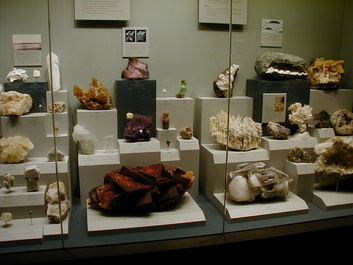
The Victorians were passionate about learning the whys and wherefores of the natural world - and so are we! Fossil hunting, visiting natural history museums, seeing wildlife shelters and discussing interesting matters with our favorite research scientists are fun ways we indulge in the Victorian obsession with the natural sciences.
The photo above with the owl was taken when we did a fundraising event for a local wildlife shelter. Athena the owl had been taken in by the shelter after being hit by a car and losing the ability to fly. Barred owls eat small songbirds, and Athena thought that Sarah's hat should be her lunch! She lost interest in us when she understood we wouldn't give her the hat.
If you are as curious about science as we are, you might enjoy these short 19th-century articles about pioneer scientist Mary Anning - one of the world's first fossil hunters, and discoverer of the pterodactyl!
The Fossil Finder of Lyme Regis
The Little Fossil Gatherer (article in an 1869 children's magazine)
The photo above with the owl was taken when we did a fundraising event for a local wildlife shelter. Athena the owl had been taken in by the shelter after being hit by a car and losing the ability to fly. Barred owls eat small songbirds, and Athena thought that Sarah's hat should be her lunch! She lost interest in us when she understood we wouldn't give her the hat.
If you are as curious about science as we are, you might enjoy these short 19th-century articles about pioneer scientist Mary Anning - one of the world's first fossil hunters, and discoverer of the pterodactyl!
The Fossil Finder of Lyme Regis
The Little Fossil Gatherer (article in an 1869 children's magazine)
Slideshow of a fossil hunting trip:
***
Sandow Routine (Gabriel)
Gabriel's daily workout is based on a routine described in Eugen Sandow's 1897 book Strength and How to Obtain It.
***
Swimming (Gabriel)
***
Picnics
"Picnic Days: ... [L]ong, happy days will be spent in the shaded woods, pleasant in social intercourse, merry with jest and song... as in no other banqueting hall..."
— From "The New Bill of Fare." "Table Talk." August, 1895. p. 272.
— From "The New Bill of Fare." "Table Talk." August, 1895. p. 272.
***
Massage
Humans have used various forms of touch to facilitate health throughout recorded history. From the early instinct to "rub" a sore spot, to modern therapeutic techniques, massage has long been part of the human experience.
The first person to apply scientific principles to massage was a Swede by the name of Pehr (sometimes anglicized as Peter) Henrik Ling. Ling developed a number of techniques to promote health through movement, and was instrumental in legitimizing massage amongst medical and scientific circles, as well as introducing its benefits to the general public. Hailed as "The Movement Cure" in the nineteenth century, Ling's techniques were developed by later massage practitioners into a modality which they termed "Swedish Massage", partially to add mystique to the treatment by associating it with an exotic land, and partially to honor its originator, known as the "Father of Massage."
Born in 1776 in Smaaland, Sweden, as a young man Ling suffered from intense rheumatism while performing military service under inclement conditions in Europe. Later he found that the pain of this condition was reduced and finally eliminated through the excercise and training involved in his study of fencing. When he later taught fencing himself at the University of Lund, Sweden, he incorporated a number of gymnastics movements into the training regimen. He was particularly interested in the utility and effects of passive and active stretching movements. As he perfected old movement techniques and established new ones, Ling's focus began to shift slightly from the use of movement for the purpose of perfecting military prowess, to its use in the treatment of disease and injury. The underlying philosophy of Ling's Swedish movement cure, as described by near contemporary Kurre W. Ostrom, is as follows: In order to achieve and maintain maximum health, it is neccessary for the full range of motion to be experienced by all muscles. This simple idea formed the basis for modern massage as it is known by most people.
To Ling's original system of "movements" or "gymnastics" was eventually added a number of strokes which, from the client's perspective, are strictly passive: effleurage, petrissage, friction, tapotement, and vibration. Whether Ling himself developed these techniques is a matter which has long been debated; certain scholars prefer to attribute them to Dr. Johan George Mezger of Holland (Ostrom, Borseth, worldmassageforum.com). Certainly, early drawings of Ling's gymnastic techniques do seem markedly different from contemporary presentations of techniques such as petrissage.
Modern Swedish massage focuses largely on relaxation, although it does have significant benefits in the realm of physical therapy as well. A 2008 issue of Medicine & Science in Sports & Excercise describes an animal research study in which compression techniques intended to mimic those involved in modern Swedish massage were proven to aid repair of muscle tissue after injury. Swedish techniques have a great deal of importance in sports massage as well; at sporting events masseurs can often be seen performing these techniques on athletes in order to flush out fatigue toxins from muscles.
The first person to apply scientific principles to massage was a Swede by the name of Pehr (sometimes anglicized as Peter) Henrik Ling. Ling developed a number of techniques to promote health through movement, and was instrumental in legitimizing massage amongst medical and scientific circles, as well as introducing its benefits to the general public. Hailed as "The Movement Cure" in the nineteenth century, Ling's techniques were developed by later massage practitioners into a modality which they termed "Swedish Massage", partially to add mystique to the treatment by associating it with an exotic land, and partially to honor its originator, known as the "Father of Massage."
Born in 1776 in Smaaland, Sweden, as a young man Ling suffered from intense rheumatism while performing military service under inclement conditions in Europe. Later he found that the pain of this condition was reduced and finally eliminated through the excercise and training involved in his study of fencing. When he later taught fencing himself at the University of Lund, Sweden, he incorporated a number of gymnastics movements into the training regimen. He was particularly interested in the utility and effects of passive and active stretching movements. As he perfected old movement techniques and established new ones, Ling's focus began to shift slightly from the use of movement for the purpose of perfecting military prowess, to its use in the treatment of disease and injury. The underlying philosophy of Ling's Swedish movement cure, as described by near contemporary Kurre W. Ostrom, is as follows: In order to achieve and maintain maximum health, it is neccessary for the full range of motion to be experienced by all muscles. This simple idea formed the basis for modern massage as it is known by most people.
To Ling's original system of "movements" or "gymnastics" was eventually added a number of strokes which, from the client's perspective, are strictly passive: effleurage, petrissage, friction, tapotement, and vibration. Whether Ling himself developed these techniques is a matter which has long been debated; certain scholars prefer to attribute them to Dr. Johan George Mezger of Holland (Ostrom, Borseth, worldmassageforum.com). Certainly, early drawings of Ling's gymnastic techniques do seem markedly different from contemporary presentations of techniques such as petrissage.
Modern Swedish massage focuses largely on relaxation, although it does have significant benefits in the realm of physical therapy as well. A 2008 issue of Medicine & Science in Sports & Excercise describes an animal research study in which compression techniques intended to mimic those involved in modern Swedish massage were proven to aid repair of muscle tissue after injury. Swedish techniques have a great deal of importance in sports massage as well; at sporting events masseurs can often be seen performing these techniques on athletes in order to flush out fatigue toxins from muscles.
***
In a seaport town in the late 19th-century Pacific Northwest, a group of friends find themselves drawn together —by chance, by love, and by the marvelous changes their world is undergoing. In the process, they learn that the family we choose can be just as important as the ones we're born into. Join their adventures in
The Tales of Chetzemoka
***
Anthologies
***
For words of wit and advice sage,
I hope you'll like my author page!
History lessons, folks who dare,
Please do share it while you're there!
YouTube.com/@Victorianlady
Thank you!
Search this website:
***
